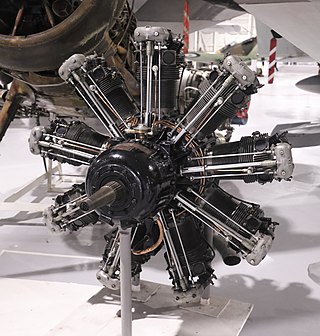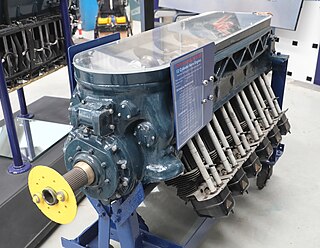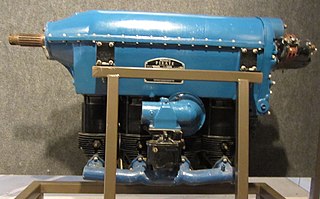
The Bristol Jupiter is a British nine-cylinder single-row piston radial engine that was built by the Bristol Aeroplane Company. Originally designed late in World War I and known as the Cosmos Jupiter, a lengthy series of upgrades and developments turned it into one of the finest engines of its era.

The Bristol Perseus was a British nine-cylinder, single-row, air-cooled radial aircraft engine produced by the Bristol Engine Company starting in 1932. It was the first production sleeve valve aero engine.

Major Frank Bernard Halford CBE FRAeS was an English aircraft engine designer. He is best known for the series of de Havilland Gipsy engines, widely used by light aircraft in the 1920s and 30s.
The Cirrus and Hermes or Cirrus-Hermes are a series of British aero engines manufactured, under various changes of ownership, from the 1920s until the 1950s. The engines were all air-cooled, four-cylinder inline types, with earlier ones upright and later designs inverted.

The Armstrong Siddeley Cheetah is a seven-cylinder British air-cooled aircraft radial engine of 834 cu in capacity introduced in 1935 and produced until 1948. Early variants of the Cheetah were initially known as the Lynx Major.

The de Havilland Gipsy Queen is a British six-cylinder aero engine of 9.2 litres (560 cu in) capacity that was developed in 1936 by the de Havilland Engine Company. It was developed from the de Havilland Gipsy Six for military aircraft use. Produced between 1936 and 1950 Gipsy Queen engines still power vintage de Havilland aircraft types today.

The de Havilland Gipsy Twelve was a British aero engine developed by the de Havilland Engine Company in 1937. Approximately 95 were manufactured. It was known as the Gipsy King in Royal Air Force service.

The de Havilland Gipsy is a British air-cooled four-cylinder in-line aircraft engine designed by Frank Halford in 1927 to replace the ADC Cirrus in the de Havilland DH.60 Moth light biplane. Initially developed as an upright 5 litre capacity engine, later versions were designed to run inverted with increased capacity and power.

The de Havilland Gipsy Six is a British six-cylinder, air-cooled, inverted inline piston engine developed by the de Havilland Engine Company for aircraft use in the 1930s. It was based on the cylinders of the four-cylinder Gipsy Major and was developed into a series of similar aero engines which were still in common use until the 1980s.

The Walter Mikron is a four-cylinder, air-cooled, inverted straight engine for aircraft.

The Blackburn Cirrus Minor is a British four-cylinder, inverted, in-line air-cooled aero-engine that was designed and built by the Cirrus Engine Section of Blackburn Aircraft Limited in the late 1930s.

The Blackburn Cirrus Major is a British, inline-four aircraft engine that was developed in the late 1930s.

The Menasco Pirate series are four-cylinder, air-cooled, in-line, inverted aero-engines, built by the Menasco Motors Company of Burbank, California, for use in light general and sport aircraft during the 1930s and 1940s. The Menasco engines came in both normally aspirated and supercharged forms, with the supercharged models exhibiting superior performance at higher altitudes, with a relatively small increase in dimensions and weight. The supercharged models had the S suffix added to their designation to show supercharging.

The ADC Cirrus is a series of British aero engines manufactured using surplus Renault parts by the Aircraft Disposal Company (ADC) in the 1920s.

The de Havilland Gipsy Minor or Gipsy Junior is a British four-cylinder, air-cooled, inline engine that was used primarily in the de Havilland Moth Minor monoplane, both products being developed in the late 1930s.

The Napier Javelin was a British six-cylinder inline air-cooled engine designed by Frank Halford and built by D. Napier & Son. First flown in March 1934 in the prototype of the Percival Mew Gull racing aircraft, the engine was also used in the Spartan Arrow biplane and the Percival Gull.

The Blackburn Cirrus Bombardier is a British four-cylinder inline aircraft engine, developed and built by the Blackburn Aircraft company in the mid-1950s. The engine featured fuel injection.
The Blackburn Cirrus Midget was a British four-cylinder, inverted, inline air-cooled aero engine designed and built in 1937 by the Cirrus Engine Section of Blackburn Aircraft Limited. Little is known of its development and use, its sole aircraft application being reported as the Chilton D.W.1 although it is possible that this did not transpire.

The Koolhoven F.K.47 was a 1930s one-off two seat biplane designed and built in the Netherlands for an individual customer as a sport and touring aircraft.

The Koolhoven F.K.54 was a Dutch single-engine, three-seat touring aircraft with a retractable undercarriage. It flew shortly before the start of World War II and its development was abandoned after its first flight as attention turned to military aircraft.






















